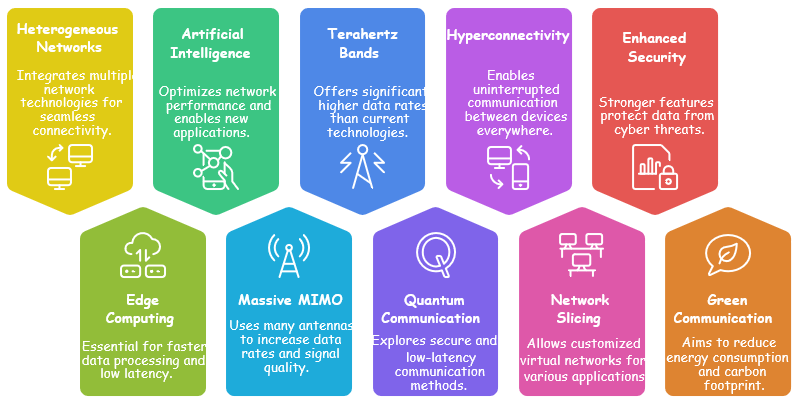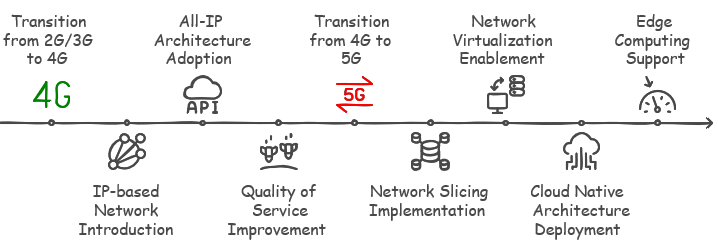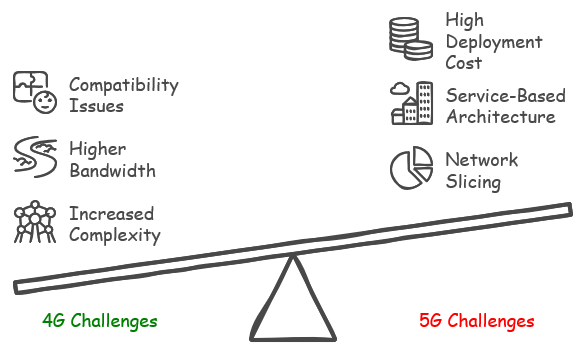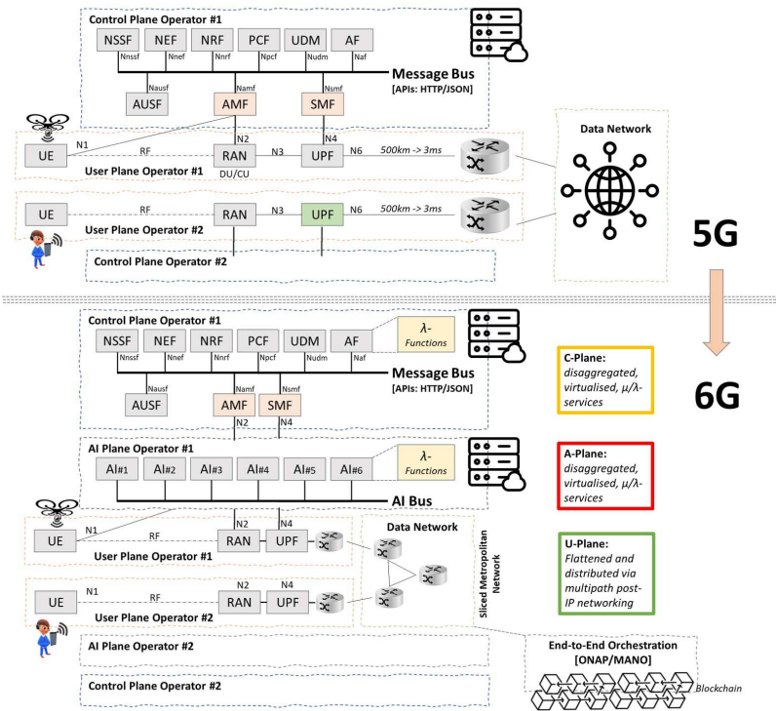|
6G System Architecture
Since 6G itself is still in the conceptual stage, it is not possible to describe clearly what the 6G System Architecture will be like. So I am trying to consolidate opinions and suggestions from various different sources just to give you some big picture on what would be the likely architecture. This involves exploring the potential feature sets of the 6G system, tracing the evolution of network architecture from 2G/3G to 4G, and then from 4G to 5G, while also examining the challenges encountered during these transitions. Additionally, I will delve into the specific challenges faced in the implementation and evolution from 2G/3G to 4G, as well as the hurdles in the progression from 4G to 5G. By considering these aspects, I aim to outline possible 6G architectures that could emerge, drawing on the lessons learned and innovations developed through the previous generations of wireless technology. This comprehensive approach will help provide a broader understanding of the trajectory and potential directions for 6G system design.
Based on 6G Use cases and KPIs, we can think of what kinds of features will be / should be supported. Some of the feature sets that are frequently described in various sources are as follows :

NOTE : You may think that most of these features are already supported by 5G. Nothing completely new except only a few. Yes, it is true but you can take that the features will be more built-in and large scale.
- Heterogeneous networks: 6G is likely to integrate multiple network technologies, such as satellite, terrestrial, and airborne networks, to provide seamless connectivity and high data rates. ==> most of these
features are already being specified in 5G for example NTN, but it is likely to be the default featureset from day 1 in 6G. The issue would be what kind of spectrum will be used and lower layer protocols to be employed.
- Edge computing: Edge computing will be an essential component of 6G architecture, allowing for faster data processing, low latency, and improved security. ==> This is also being deployed in 5G, but I think this
would be more of business decision rather than technical issue.
- Artificial intelligence (AI): AI is expected to play a significant role in 6G systems, from optimizing network performance to enabling new applications and services. ==> In 5G, it is planned that AI will be adopted
from Rel 18 or later but in 6G it is expected to be a default feature and the whole end-to-end system will be designed to integrate AI.
- Massive MIMO: 6G networks are likely to use massive MIMO (multiple-input, multiple-output) technology, which uses a large number of antennas to increase data rates and improve signal quality. ==> You all remember
that Massive MIMO was one of buzzwords for 5G. Same would apply to 6G, but the scale of anntenna array would be greatly different. In 5G, 32 or 64 Antenna Elements with gNB and 2 or 4 Antenna element on UE are the most common implmentation, but in 6G the scale will be at the scale of hundreds or thousands if it will use sub-terahertz / terahertz spectrum.
- Terahertz frequency bands: 6G is expected to use terahertz frequency bands, which offer significantly higher data rates than the millimeter-wave frequencies used in 5G networks. ==> This will be the most disruptive
feature in 6G.
- Quantum communication: Researchers are exploring the potential of quantum communication to provide highly secure and low-latency communication in 6G systems. ==> This are mentioned/discussed in some documents and
discussion, but personally I don't think it is highly likely to have this in 6G cellular system.
- Hyperconnectivity: 6G is expected to provide ubiquitous and seamless connectivity, enabling devices to communicate with each other without any interruptions, regardless of location.
- Network slicing: 6G networks may offer network slicing, which allows network operators to create customized virtual networks for different use cases and applications. ==> This is also a buzzword for 5G network
and will be applicable to 6G as well. But it should be more scalable and granular to support the diverse use cases proposed in 6G.
- Enhanced security: 6G networks are expected to have stronger security features, such as quantum encryption, to protect data from cyber attacks. ==> I think this will be an important topic in 6G since we have seen
a lot of concerns about security with existing technology.
- Green communication: Researchers are exploring the potential of 6G to reduce energy consumption and minimize the carbon footprint of wireless communication. ==> I think this is an ongoing effort even now and being discussed for a 6G feature, but how this feature should be described in terms of industry specification.
Before we think of the details of future system architecture, it would be worth reviewing the evolutionary path from old technology to current 5G network. We will see some disruptive new technology in 6G (like AI, Terahertz spectrum) but in most case the current techonlogy will just be extended and revised to support the use case of future system.

- Packet switching: 2G/3G networks primarily use circuit-switched networks, whereas 4G networks use packet-switched networks. Packet switching is more efficient than circuit switching because it allows data to be transmitted in small packets, which can be routed through the network more efficiently.
- IP-based network: 4G networks are designed to be IP-based, which means that they use the same networking protocols as the internet. This allows for a more seamless integration between mobile networks and the internet.
- All-IP architecture: 4G networks are designed to have an all-IP architecture, which means that all data, voice, and video traffic is transmitted over the same IP network. This is in contrast to 2G/3G networks, which use separate networks for voice and data.
- Quality of service (QoS): 4G networks are designed to provide better QoS than 2G/3G networks. This is achieved through the use of QoS mechanisms such as policy and charging control, which allow operators to allocate network resources more efficiently
- Network Slicing: 5G networks are designed to support network slicing, which allows operators to create multiple virtual networks that can be optimized for specific use cases, such as IoT, ultra-low latency, or high-bandwidth applications. Each slice can have its own network architecture and quality of
service (QoS) requirements, allowing operators to offer more customized services to their customers.
- Network virtualization. It refers to the ability to create multiple virtual networks on top of a shared physical network infrastructure. This allows operators to offer customized services to their customers, each with its own network architecture and quality of service (QoS) requirements. Network virtualization also enables operators to optimize network
resources by dynamically allocating them based on the needs of each virtual network
- Cloud Native Architecture: 5G networks are built on a cloud-native architecture, which means that they use virtualization, software-defined networking (SDN), and network functions virtualization (NFV) to create a more flexible and scalable network. This allows operators to deploy new services and applications
more quickly and efficiently.
- Edge Computing: 5G networks are designed to support edge computing, which allows applications and services to be hosted closer to the end user. This can reduce latency and improve the user experience for applications that require real-time data processing.
For every evolution, there has been challenges of its own. The history of the evolution was the process of overcoming those challenges. In this section, I want to briefly go over what kind of challenges that we had in previous technologies. These challenges have played a critical role in shaping the development and deployment of each generation of wireless technology, from 4G to 5G and beyond.

- Increased Complexity: The 4G core network architecture is more complex than the 2G/3G core network architecture, with a greater number of network nodes, interfaces, and protocols. This complexity made it more challenging to design, deploy, and operate 4G core networks.
- Higher Bandwidth Requirements: 4G networks require much higher bandwidth than 2G/3G networks, which made it necessary to deploy new network infrastructure, such as fiber optic cables and small cell sites, to support the increased data traffic. ==> At the point of 3G to 4G transition, the bandwidth of 3G single cell was 5 Mhz (3.8 Mhz effective bandwidth) and the max channel bandwidth of 4G(LTE) single cell was 20 Mhz. It was huge expansion of the bandwidth even though 20Mhz
bandwidth
would look almost nothing from the 5G point of view. I think the requirement of this bandwidth expansion was the biggest motivation of employing OFDM in 4G.
- Compatibility with Legacy Networks: 4G networks needed to be compatible with legacy 2G/3G networks, which meant that they had to support a wide range of network protocols and interfaces. This added complexity to the 4G network architecture and made it more challenging to ensure seamless handover between
different network technologies.
- Spectrum Availability: 4G networks require access to a greater amount of spectrum than 2G/3G networks, particularly for high-bandwidth applications. This created challenges in terms of spectrum availability and management, particularly in crowded urban areas.
- Security: The increased complexity and bandwidth requirements of 4G networks created new security challenges, particularly in terms of protecting against cyberattacks and ensuring the privacy and confidentiality of user data.
- Network slicing: One of the primary features of 5G core networks is the ability to slice the network to create virtualized subnetworks tailored to specific use cases, such as smart cities, connected cars, or industrial automation. However, creating and managing these network slices requires significant
coordination between different stakeholders and careful allocation of resources.
- Service-based architecture: 5G core networks are built on a service-based architecture (SBA) that allows for more flexible and efficient service creation and delivery. However, this also requires a shift in the way services are designed, developed, and deployed, as well as changes to existing business
and operational support systems.
- Increased complexity: 5G core networks are more complex than 4G networks, with new features and functions such as network function virtualization (NFV), software-defined networking (SDN), and cloud-native applications. Managing this complexity requires new skills, tools, and processes, as well as a more
comprehensive approach to security and risk management.
- Interoperability: There are challenges in ensuring interoperability between different vendors' equipment and services. This requires coordination between vendors, network operators, and industry groups to ensure that 5G networks are compatible and able to deliver the promised benefits.
- Cost: Building and deploying 5G core networks requires significant investment, not only in new infrastructure but also in new skills and capabilities. This can be a challenge for network operators, particularly in competitive markets where the benefits of 5G may not be immediately clear to consumers
and businesses.
One of the proposed 6G architecture is as follows. the architecture shown below presents a vision for a future 6G network that is more disaggregated, AI-driven, and uses advanced networking techniques beyond current IP-based systems. It suggests a network architecture that is fundamentally different from 5G, aiming to be more adaptable, efficient, and integrated with AI and possibly blockchain technologies.

Source : 6G Wireless Systems: Vision,Requirements, Challenges,Insights, and Opportunities
Following is breakdown of this architecture :
-
C-Plane: It is disaggregated, virtualized, and includes AI-driven services. Disaggregation refers to separating software from hardware, allowing for more flexibility and scalability. Virtualization allows network functions to run as software instances, which can be dynamically deployed as needed. AI services might include automated network optimization, predictive maintenance, and advanced security features.
- A-Plane: This represents an AI plane, presumably a new layer or aspect of the network that is dedicated to AI processing and functions. This suggests that AI will play a larger role in managing and operating the network, perhaps enabling real-time analytics, decision-making, and network adjustments.
- U-Plane: It is flattened and distributed via multipath post-IP networking, which could mean that the data transfer mechanisms are more decentralized and use multiple pathways to optimize connectivity and reliability. Post-IP networking implies the use of a networking protocol that would come after the Internet Protocol (IP), potentially addressing its limitations.
-
This architecture includes elements like AI Bus, suggesting a dedicated communication infrastructure for AI components, and End-to-End Orchestration with ONAP/MANO (Open Network Automation Platform/Management and Orchestration), which is a platform for the design, creation, orchestration, monitoring, and lifecycle management of virtual network functions.
Reference
YouTube
|
|



